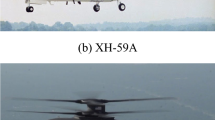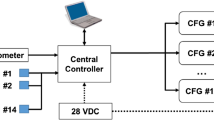Abstract
A simulation study using an active vibration control system (AVCS) to reduce airframe vibrations of an unmanned compound helicopter is conducted. The present unmanned compound helicopter uses wings, propellers, and a lift-offset coaxial rotor system, with two blades per rotor for high-speed flight. The airframe vibration responses are reduced using the AVCS at 230 knots. The hub vibratory loads of a lift-offset coaxial rotor are calculated using a rotorcraft comprehensive analysis code, CAMRAD II. The obtained rotor vibratory loads excite the airframe structure, represented as a one-dimensional stick (elastic line) model. The finite element analysis software, MSC.NASTRAN, is used to model the structural dynamics and analyze the vibration response of the airframe. The AVCS in this work uses the Fx-LMS (Filtered-x Least Mean Square) algorithm to determine the vibration cancellation signal produced by the force generators, which has the same amplitude but opposite direction to the airframe vibration signal. Herein, the AVCS consists of four force generators and six accelerometers and the simulation framework is constructed using MATLAB Simulink. Ten AVCS simulations are conducted, considering the different locations and various directions of the vibration cancellation forces from the force generators. When AVCS is applied to the airframe at a flight speed of 230 knots, the 2/rev longitudinal and vertical vibration responses at the specified airframe positions, such as the remote cockpit device, wing root, and wing tip, are reduced by 81.39–99.93%, compared to the baseline results without AVCS application.






















Similar content being viewed by others
References
Bagai A (2008) Aerodynamic design of the X2 technology DemonstratorTM main rotor blades. In: 64th American Helicopter Society Annual Forum
Ruddell AJ (1981) Advancing blade concept (ABC) technology demonstrator. USAAVRADCOM-TR-81-D-5
Blackwell R, Millott T (2008) Dynamics design characteristics of the sikorsky X2 TechnologyTM demonstrator aircraft. In: 64th American Helicopter Society Annual Forum
Walsh D, Weiner S, Arifian K, Lawrence T, Wilson M, Millott T, Blackwell R (2011) High airspeed testing of the sikorsky X2 TechnologyTM demonstrator. In: 67th American Helicopter Society Annual Forum
Kim D-H, Kim T-J, Jung S-U, Kwak D-I (2016) Test and simulation of an active vibration control system for helicopter applications. Int J Aeronaut Sp Sci 17(3):442–453
Kim D-H, Kwak D-I, Song Q (2019) Demonstration of active vibration control system on a Korean Utility Helicopter. Int J Aeronaut Sp Sci 20(1):249–259
Lee Y-L, Kim D-H, Park J-S, Hong S-B (2020) Vibration reduction simulations of a lift-offset compound helicopter using two active control techniques. Aerosp Sci Technol 106:Article 106181
Millott T, Goodman R, Wong J, Welsh W, Correia J, Cassil C (2003) Risk reduction flight test of a pre-production active vibration control system for the UH-60M. In: 59th American Helicopter Society Annual Forum
Goodman R, Millott T (2000) Design, development, and flight testing of the active vibration control system for Sikorsky S-92. In: 56th American Helicopter Society Annual Forum
Rangacharyulu MA, Moore MJ (1991) Flight vibration testing of the V-22 Tiltrotor aircraft. In: 47th annual forum of the American Helicopter Society
Johnson W (2012) CAMRAD II: comprehensive analytical method of rotorcraft aerodynamics and dynamics. Johnson Aeronautics, Palo Alto
Liu Y, Han J, Xue Z, Zhang Y, Yang Q (2019) Structural vibrations and acoustic radiation of blade–shafting–shell coupled System. J Sound Vib 463:Article 114961
Yeo H, Chopra I (2001) Coupled rotor/fuselage vibration analysis for teetering rotor and test data comparison. J Aircr 38(1):111–121
Kwon Y-M, Park J-S (2020) Performance and airloads analyses for a rigid coaxial rotor of high-speed compound unmanned rotorcrafts. J Korea Inst Milit Sci Technol 23(4):311–318
Jacobellis G, Anusonti-Inthra P, Gandhi F (2018) Investigation of blade loads on a modern high-speed lift-offset coaxial helicopter using coupled computational fluid dynamics/computational structural dynamics. American Helicopter Society International Aeromechanics Specialists’ Meeting
Kwon Y-M, Park J-S, Wie S-Y, Kang HJ, Kim D-H (2021) Aeromechanics analyses of a modern lift-offset coaxial rotor in high-speed forward flight. Int J Aeronaut Sp Sci 22(2):338–351
Drela M (1996) A user’s guide to MSES 2.95, MIT Computational Aerospace Science Laboratory
Chopra I (2018) Design and testing of scaled rotor models. In: 7th Asian/Australian Rotorcraft Forum, Short Course Note
Klimchenko V, Baeder JD (2020) “CFD/CSD study of interactional aerodynamics of a coaxial compound helicopter in high-speed forward flight. AIAA Scitech 2020 forum
Lim JW (2015) Consideration of structural constraints in passive rotor blade design for improved performance. Aeronaut J 119(1222):1513–1539
Abhishek A, Chopra I, Purekar A, Wang G, Phan N, Semidey R, Liebshutz D (2012) Rotor load prediction using coupled rotor/fuselage model and sensor data. In: 68th American Helicopter Society Annual Forum
Colombo F, Muscarello V, Quaranta G, Masarati PA (2018) Comprehensive aerosevoelastic approach to detect and prevent pilot assisted oscillations in tiltrotors. In: 74th American Helicopter Society Annual Forum
Dompka RV (1989) Investigation of difficult component effects on finite element model vibration prediction for the Bell AH-1G helicopter. NASA CR 181916
Howland GR, Durno JA, Twomey WJ (1990) Ground shake test of the UH-60A helicopter airframe and comparison with Nastran finite element model predictions. NASA CR 181993
Elliott SJ, Nelson PA (1993) Active noise control. IEEE Signal Process Mag 10(4):12–35
Acknowledgements
This work was conducted at High-Speed Compound Unmanned Rotorcraft (HCUR) research laboratory with the support of Agency for Defense Development (ADD). This research was supported by Basic Science Research Program through the National Research Foundation of Korea (NRF) funded by the Ministry of Education (2020R1I1A3071793). This work was supported by the National Research Foundation of Korea (NRF) Grant funded by the Korea Government (MSIT) (2021R1A5A1031868).
Author information
Authors and Affiliations
Corresponding author
Ethics declarations
Conflict of interest
The authors declare that there is no conflict of interest regarding the publication of this paper.
Additional information
Publisher's Note
Springer Nature remains neutral with regard to jurisdictional claims in published maps and institutional affiliations.
Rights and permissions
About this article
Cite this article
Hong, SB., Lee, YL., Kwon, YM. et al. Airframe Vibration Reduction for an Unmanned Lift-Offset Compound Helicopter Using Active Vibration Control System. Int. J. Aeronaut. Space Sci. 23, 102–114 (2022). https://doi.org/10.1007/s42405-021-00426-3
Received:
Revised:
Accepted:
Published:
Issue Date:
DOI: https://doi.org/10.1007/s42405-021-00426-3




